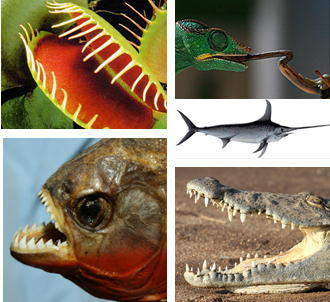carnivores in paradise?
02-07-2014 - Posted by Andre Piet In a couple of previous blogs, I explained that the transience of creation, “from the beginning,” is a given. Indeed, death entered the world of humanity because Adam and Eve were denied access to the “tree of life”, after they had eaten of the forbidden tree. But the phenomenon of “death,” itself, was already known to them. Adam and Eve saw it in nature, all around them. Outside the garden of Eden, the earth was not exactly a paradise. Of Adam in the garden, we read that God brought all the animals to him.
In a couple of previous blogs, I explained that the transience of creation, “from the beginning,” is a given. Indeed, death entered the world of humanity because Adam and Eve were denied access to the “tree of life”, after they had eaten of the forbidden tree. But the phenomenon of “death,” itself, was already known to them. Adam and Eve saw it in nature, all around them. Outside the garden of Eden, the earth was not exactly a paradise. Of Adam in the garden, we read that God brought all the animals to him.
…to see what he will call it. And whatever the human living soul is calling it, that is its name. 20 And calling is the human the names for every beast and for every flyer of the heavens, and for all field life… -Gen.2:19,20 (CLV)-
Adam understood the animals, and the Hebrew names that he gave them (like Adam, itself, which is also a Hebrew name) characterize their identity. Let’s take a closer look at some of the names the flesh-eating animals. The word lion in Hebrew (arje; Str. 738) is derived from a verb that signifies violent plucking or pulling. The word for owl (tachmac; Str. 8464) is derived from a word that refers to violence. The word for eagle (nesher; Str. 5404) is derived from a stem that refers to rip open or rupture. The word for vulture (perec; Str. 6539) is derived from a verb which means split or break. And the word for (horn)snake (shphiyphon; Str. 8207) is derived from a verb which is translated with bruise. As far as we know, the names of these animals (and, of course, the list is far from complete) go back to Adam in the garden. They characterize the animals which God had created, “each according to its kind (nature).” God made them with their jagged teeth, their poisonous tongue or their sharp beak and with a (relatively) short intestines. The spider, He enabled to artfully make an elaborate web to catch insects, while the chameleon, for the same purpose, was given an exceptionally speedy tongue. The swordfish, He equipped with a sword, to be able to catch its prey. And piranhas, He gave extremely sharp teeth. The anteater He gave a sticky tongue for eating ants and termites. And how about the tentacles which were given to octopuses and sea anemones? Or the mechanisms by which He provided for carnivorous plants? And so on. But does it not say in Gen.1:30 that all animals were herbivores?
And to every animal of the earth, to every flyer of the heavens, and to every creeper on the earth in which there is a living soul, I have given all green herbage for food. And it came to be so. (CLV)
The green herb (vegetation) is the food for the animal world; for herbivores, but also, indirectly, for predators, because predators eat… herbivores. The first thing a predator eats of its prey is the abdomen containing the plant food. Nowhere in the Bible do we read that the menu of the animals was changed, after Adam ate of the forbidden fruit. Concerning man, we do read of such a change. Man was originally a fruit and plant eater and only after the flood, was the eating of flesh introduced (Gen.9:3). Traditional Christianity cannot cope with the origin of evil, such as pain and death. It cannot believe that God, Himself, created the serpent (Gen.3:1), but also the shark, the hyena and the crocodile and the Osprey, each “after their kind”. Scripture, itself, declares that it is God who gives the lion his prey (Ps.104:21). God has subjected the creation to the condition of transience (Rom.8:20). And because it is in the plan of the Creator, it is good. ‘Good’ is the qualification which resounds throughout Genesis 1. “And God saw that it was good” (1:10,12,18,21,25). It was good, but not perfect. Perfection He has reserved for the new creation. ![]()

 English Blog
English Blog